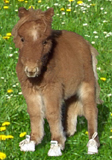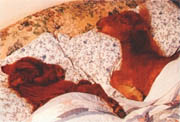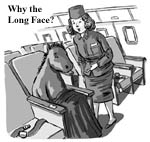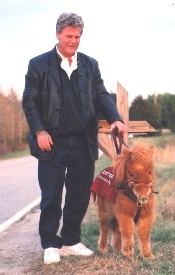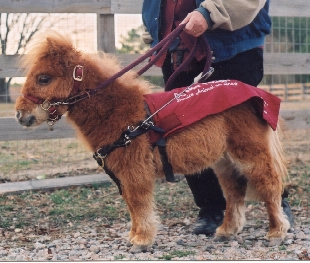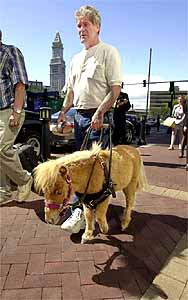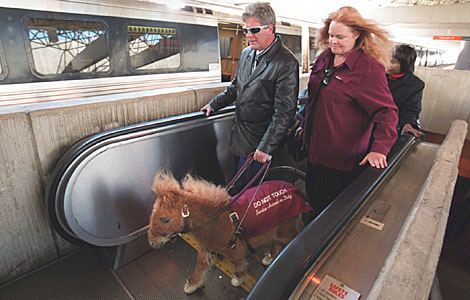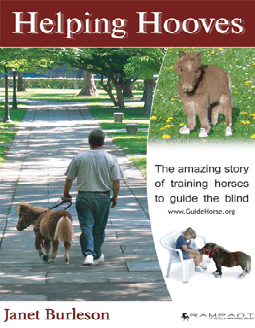|
|
Raleigh --- Cuddles doesn't wear shoes back on the farm. But here at Crabtree Valley Mall, the tiny pony wears white baby shoes --- four of them --- during her training to guide a blind person. That person is 44-year-old Dan Shaw, who sells bait and tackle in Ellsworth, Maine. On March 3, he plans to rendezvous with year-old Cuddles at the Raleigh-Durham International Airport as they prepare for their new lives together. On March 6 their unusual journey will carry them to Atlanta, where Shaw and his shaggy, reddish-brown companion plan to practice riding escalators, elevators, moving sidewalks and people movers in Hartsfield International Airport. They also want to ride MARTA, Atlanta's rapid transit, to prepare for riding the subway in Boston, where Shaw has relatives. "There has never been a horse on MARTA before," said transit system spokeswoman Kimberly Willis. But as long as Cuddles is serving as a "service animal" to Shaw, it is entitled by the Americans with Disabilities Act to ride MARTA, she said. Hartsfield spokeswoman Yolanda Clark said she "would assume" Cuddles would have the same rights as any Guide Dog. It "gives me tears" to think about meeting Cuddles, Shaw said. "I just can't wait for the freedom of walking down the street with Cuddles," said Shaw, who lost his vision to an eye disease 27 years ago. He is married, with four children and 12 grandchildren. Of Cuddles, he said, "She will be like family." Cuddles' trainer, 46-year-old Janet Burleson, said her pupil will be the first Guide Horse for the Blind, at least in the seven decades since Guide Dogs have emerged as the dominant guide for blind and visually impaired people. The Burlesons' foundation is not affiliated with the organization that trains Seeing Eye dogs. At 55 pounds and 21 inches tall at the shoulder, Cuddles is one of a dozen pygmy ponies that Burleson and her husband, Donald, raise on their Rocky Ford, N.C., farm. A year ago, they created the nonprofit Guide Horse Foundation with the goal of providing an alternative to Guide Dogs, which for some blind and visually impaired people aren't an attractive option. According to the nonprofit The Seeing Eye Inc., it has trained more than 12,500 dogs since 1929 for nearly 6,000 people in the United States and Canada. But Shaw said he never sought a Guide Dog because he figured it would die before he did, leaving him to grieve and to face finding another dog, which he might outlive as well. He figures Cuddles might outlive him. "She will live like 35 years," said Shaw, who learned about the Burlesons' ponies last spring from the television program "Ripley's Believe It or Not." "I said to my wife, 'That is what I want,' " Shaw said. "I'd be proud to walk down the street with a pony." Most of the estimated 100,000 miniature horses in the United States are pets, Donald Burleson said. In North Carolina, the Burlesons transport Cuddles to Raleigh shopping malls in their dark green minivan. It's essentially a rolling litterbox, with the floor behind the front seats covered with wood chips. When she has to go, Cuddles scratches her right front hoof on the ground, and the Burlesons lead her with rope and harness to the car. Donald Burleson customized two pairs of baby shoes by removing the heels and sewing together the leather uppers at the back. They protect Cuddles' feet from broken glass and hot asphalt and keep her from slipping on tile and hardwood floors. One recent afternoon, the Burlesons took Cuddles to lunch at the Tip Top Drive-In & Restaurant in Henderson, N.C. The women in a corner booth stared and smiled faintly as Janet Burleson forced the pony down onto the floor, where she eventually fell asleep. Diner Richard Meador sat down nearby. He looked, then looked again. "Is that real?" he said. "It looks stuffed." "He is a seeing-eye horse," waitress Tammy West said. Added the restaurant's owner, Eddie Short, "I love her like a child." The Burlesons said they have a waiting list of more than 30 people who would like guide ponies. After turning Cuddles over to Shaw in May, Janet Burleson plans to train one every two or three months. Their charity gives them away free of charge, forcing them to rely on contributions to buy, train and care for the ponies. The foundation received $30,000 last year from crime novelist Patricia Cornwell, whose gift enabled the Burlesons to buy six ponies at auction in South Carolina. Pygmy ponies cost from $2,000 to $6,000. Cornwell's gift also pays for the animals' care and training. After Burleson called them, the ponies emerged from a weathered barn. In the warm sun, they ran and playfully butted heads. The ponies have strong memories and excellent night vision. The Burlesons also discovered two years ago, when they rented saddle horses to ride in New York City, that the animals are calm in traffic. The horses they rode had been trained to turn at certain intersections, suggesting to the Burlesons that their ponies could be trained to guide the blind. Back in North Carolina, they trained their pet pony, Twinkie, with the help of a blind woman in Raleigh. Of critical importance was the pony's ability to learn "intelligent disobedience," Donald Burleson said. That skill would come in handy if the pony's blind owner signaled for it to cross the street into oncoming traffic, he explained. "You can train a horse to do anything a dog can do," Burleson said. "If we were deciding what kind of animal to use 100 years ago, when most people owned horses, horses would be a natural choice."
|
Guides Training Press Photos News Apply FAQ Wishes Contact Home
|
|
Copyright © 1998 - 2005 by the Guide Horse Foundation Inc. Guide Horse ® Guidehorse ® and Helping Hooves ® are registered trademarks. |
The Guide Horse Foundation has the utmost respect for The Seeing Eye® and their seventy-two years of outstanding work with assistance animals for the blind. Even though the press often calls our horses "seeing eye horses", please note that The Guide Horse Foundation is not affiliated with or sanctioned by the Seeing-Eye® or any of the Guide Dog training organizations. Seeing-Eye® is a registered trademark of the Seeing-Eye, Inc.
